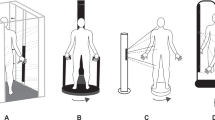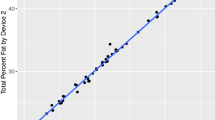Abstract
Objectives: Air displacement plethysmography (ADP) may provide a partial alternative to body density (Bd) and therefore body composition measurement compared to conventional hydrodensitometry (Hd) in children. As there are no evaluation studies of ADP in children, this study had a two-fold objective: to compare Bd estimates by ADP and Hd; and to compare fat estimates by both ADP and Hd to fat estimates by another reference method, dual energy X-ray absorptiometry (DXA).
Setting: Obesity Research Center, St. Luke’s/Roosevelt Hospital, New York, USA.
Subjects: One hundred and twenty subjects (66 females/54 males) who ranged in age from 6–86 y and in body mass index (BMI, kg/m2) from 14.1–40.0 kg/m2 met study entry criteria.
Study Design: Cross-sectional study of healthy children (age≤19 y) and adult group for comparison to earlier studies. Each subject completed ADP, Hd, and DXA studies on the same day. Only subjects with subjectively-judged successful Hd studies were entered into the study cohort.
Results: There was a high correlation between Bd by ADP and Hd (Bd Hd=0.11+0.896×Bd ADP; r=0.93, SEE=0.008 g/cm3, P<0.0001), although the regression line slope and intercept differed significantly from 1 and 0, respectively. Additional analyses localized a small-magnitude Bd bias in the child (n=48) subgroup. Both ADP and Hd%fat estimates were highly correlated (r>0.9, P<0.0001) with%fat by DXA in child and adult subgroups. Bland–Altman analyses revealed no significant%fat bias by either ADP or Hd vs DXA in either children or adults, although a bias trend (P=0.11) was detected in the child subgroup.
Conclusion: With additional refinements, the air displacement plethysmography system has the potential of providing an accurate and practical method of quantifying body fat in children as it now does in adults.
Sponsorship: This study was in-part supported by NIH Grants RR00645, NIDDK 42618 and NIDDK 37352.
This is a preview of subscription content, access via your institution
Access options
Subscribe to this journal
Receive 12 print issues and online access
$259.00 per year
only $21.58 per issue
Buy this article
- Purchase on Springer Link
- Instant access to full article PDF
Prices may be subject to local taxes which are calculated during checkout
Similar content being viewed by others
Author information
Authors and Affiliations
Contributions
Contributers: All author were co-investigators on the project and contributed equally to the development of the manuscript. Both C Nuñez and AJ Kovera performed all of the techinical measurements
Rights and permissions
About this article
Cite this article
Nuñez, C., Kovera, A., Pietrobelli, A. et al. Body composition in children and adults by air displacement plethysmography. Eur J Clin Nutr 53, 382–387 (1999). https://doi.org/10.1038/sj.ejcn.1600735
Received:
Revised:
Accepted:
Published:
Issue Date:
DOI: https://doi.org/10.1038/sj.ejcn.1600735
Keywords
This article is cited by
-
Body composition assessment in a large cohort of Olympic athletes with different training loads: possible reference values for fat mass and fat-free mass domains
Acta Diabetologica (2023)
-
Estimating trunk fat in children according to sex using basic somatic readings: an opportunity for improving evaluation among girls
BMC Pediatrics (2021)
-
D3-creatine dilution for the noninvasive measurement of skeletal muscle mass in premature infants
Pediatric Research (2021)
-
Reliability and Intermethod Agreement for Body Fat Assessment Among Two Field and Two Laboratory Methods in Adolescents
Obesity (2012)
-
Air-displacement plethysmography for the measurement of body composition in children aged 6–48 months
Pediatric Research (2012)



